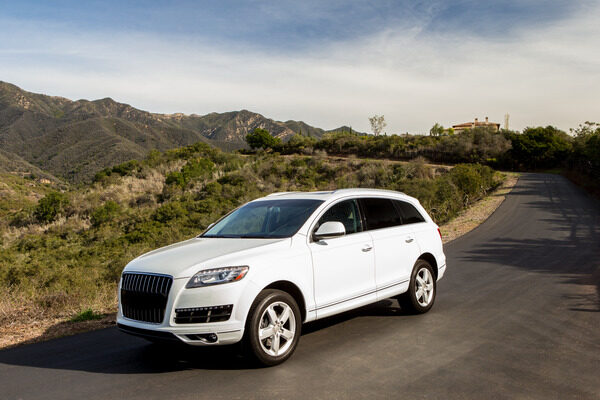
While wheel alignment and balance both contribute to a smoother ride, the services are quite different. A wheel alignment makes sure your tires contact the road in the correct way by adjusting the angles of your tires, while a tire balance corrects the weight imbalance on the wheel and tire.
Here’s a deeper dive into the differences, the causes of misalignment and balance issues, the symptoms of each and more.
Wheel alignment overview
What is wheel alignment?
Wheel alignment is the adjustment of the angles of the tires on the car to maximize the amount of contact your wheel has with the road. If your wheels are misaligned and pointing in different directions, this causes uneven wear and can actually cause your car to pull either right or left.
What causes wheel misalignment?
There are several reasons your wheels could be misaligned, including:
- Hitting a pothole, curb or speedbump while driving too fast.
- Your car’s shocks or struts have loosened or become worn down.
- Modifying the height of your car without modifying the suspension.
How often should you get an alignment?
It’s recommended that you have your alignment checked about once a year, but because your mileage may vary greatly in a year, consider getting your alignment checked every other oil change. But there are driving factors that indicate your car needs an alignment. [1]
Signs you may need a wheel alignment
Here are some symptoms that might indicate you need a wheel alignment:
- Your car pulls to the right or left.
- Your car is shaking while on the road.
- The ride is bumpy.
- Your tires are wearing rapidly or unevenly.
- Your steering wheel isn’t straight.
Types of wheel alignments
There are 3 main types of wheel alignments:
- Front end: When only the front axle is measured and adjusted.
- Thrust: Recommended for cars with a solid rear suspension, this ensures that all 4 wheels are squared with each other.
- Four wheel: A combination of the other alignments, this measures and positions the rear axle angles and restores all 4 corners of your car to the manufacturer’s specifications. [2]
How much does a wheel alignment cost?
Costs to realign wheels can vary. Some places offer lifetime alignment packages that are scheduled every 6,000 miles or as needed for your vehicle. Keep in mind that the cost of a routine wheel alignment or lifetime alignment package depends on the current inflation rate as well as your location. Always get an estimate from your mechanic on costs associated with wheel alignment.
Tire balancing overview
What is tire balancing?
Tire balancing helps optimize your tires’ overall performance by ensuring that each wheel has the same driving pressure applied evenly. When tires are balanced, both the tire and wheel are placed on a machine that shows the lighter and heavier areas. Once pointed out, the mechanics add weights to specific areas on the tire to balance it out. There are a few different ways to do this, depending on the type of vehicle.
What causes tires to be out of balance?
The cold air can deflate your tires so much that they become unbalanced. Another reason your tire could be unbalanced could be that you hit a speed bump, curb, pothole or another type of object on the road at a relatively high speed.
How often do tires need to be balanced?
You should balance your tires periodically to prevent future car issues. It’s recommended to do it about every 6,000 to 8,000 miles or whenever you’re noticing symptoms. This can vary per vehicle, so make sure to check your owner’s manual and/or take your car in for regular maintenance. [3]
Wheel balance symptoms
Keep an eye out for these symptoms that can indicate your wheels need to be balanced:
- Vibrations in the steering wheel, floorboard, or seats.
- Tires are wearing down unevenly.
- Your car is pulling to one side while driving.
- Poor fuel economy and higher fuel costs over time.
How to tell which tire is out of balance
It can be difficult to figure out which tire is the one out of balance, but there are methods a professional can use to figure it out:
- Check your tires pressures for consistency. Look for distinct variance among them.
- Feel around the circumference of each tire, feeling for signs of uneven wear and flat spots.
- In a safe space and following your car’s instruction manual, use a jack to lift your car up one wheel at a time. Then spin the raised wheel, looking for wobbling, and listening for any odd humming sounds. Repeat for each wheel. [4]
Static vs. dynamic balancing
When the balance occurs on a single plane of reference, typically through the middle axis of the hub, this is called static balancing. While it used to be popular, static balancing is now viewed as out of date and not a best practice within the industry; dynamic balancing is recommended instead. When balancing occurs over multiple planes, this is called dynamic balancing. [5]
What does wheel balancing cost?
Wheel balancing costs can vary. If you opt for standard balancing costs, it usually costs less than when specialized equipment is used to solve balancing issues that a standard balancing can’t fix. Keep in mind that the cost of wheel balancing depends on many factors, including your location. Always get an estimate from your mechanic on costs associated with wheel balancing.
Wheel alignment and balancing review
Both wheel alignment and tire balancing are crucial for the maintenance and upkeep of your car. It’s also important to know the signs and symptoms of both so that you know when to take your car to a professional. Lastly, it’s essential that you have the right auto insurance to protect yourself and your car while on the road.
Sources:
[1] “How Often Do You Need A Wheel Alignment?” telletire.com/how-often-do-you-need-a-wheel-alignment (Accessed October 2023)
[2] “What are the different types of wheel alignments?” tyreright.com.au/expert-tips/what-are-the-different-types-of-wheel-alignment (Accessed October 2023)
[3] “Unbalanced Tires: Symptoms & What You Can Do About It,” creamerytire.com/blog/unbalanced-tires-symptoms-and-what-you-can-do-about-it (Accessed October 2023)
[4] “How to Tell Which Tire is Out of Balance,” Will Creech, tiregrades.com/tire-maintenance/balancing/how-to-tell-which-tire-is-out-of-balance (Accessed February 2023)
[5] “How Much Does Tire Balancing Cost? (Comparing 11 Service Centers),” Steve Cooper, autotrends.org/tire-balancing-cost (Accessed November 2022)
Disclaimer:
The information included here is designed for informational purposes only. It is not legal, tax, financial or any other sort of advice, nor is it a substitute for such advice. The information may not apply to your specific situation. We have tried to make sure the information is accurate, but it could be outdated or even inaccurate in parts. It is the reader’s responsibility to comply with any applicable local, state or federal regulations. Nationwide Mutual Insurance Company, its affiliates and their employees make no warranties about the information or guarantee of results, and they assume no liability in connection with the information provided. Nationwide and the Nationwide N and Eagle are service marks of Nationwide Mutual Insurance Company. © 2024 Nationwide



